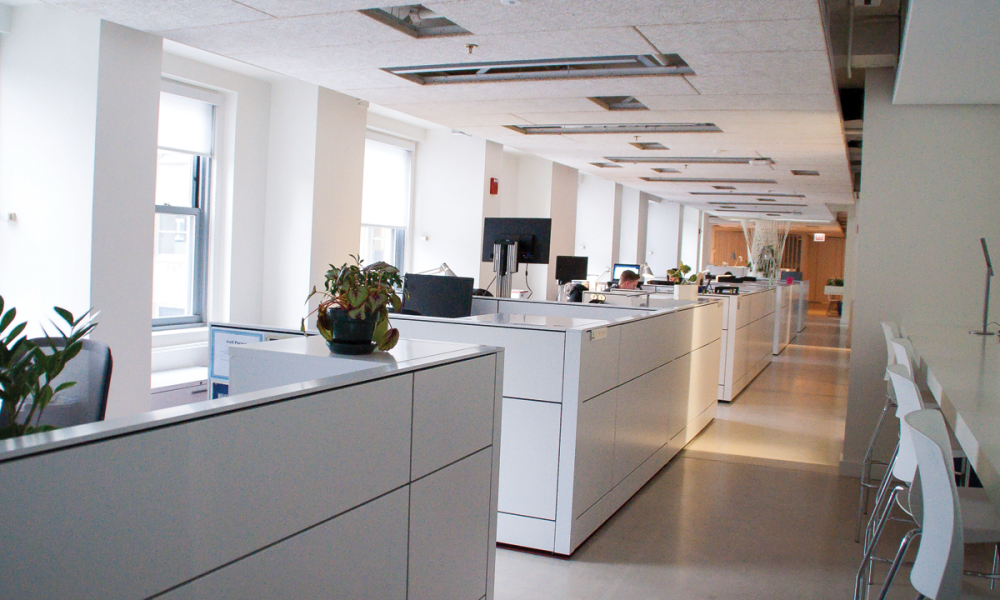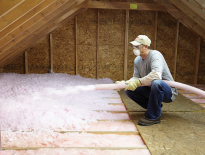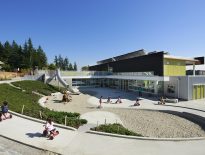The Natural Resources Defense Council (NRDC) did not think twice about pursuing Living Building Challenge Certification for the expansion of their Petal Certified Midwest office, located in the Civic Opera House Building in downtown Chicago, Illinois. After two years of occupancy in the office, it became clear that the efforts made under the guidance of the LBC standards created a unique workspace that makes NRDC staff feel healthy, productive and rejuvenated.
While the project began as a 2,500 square foot addition to the 9,852 square foot office, about halfway through the design process, additional office space opened up next door, which NRDC quickly included into the final 3,700 sf expansion. The new space, consisting of two wings that are connected to the first phase of the office, is also located on the sixteenth floor of the Civic Opera House. The combined open office workspace has a total capacity of 18 workspaces and 7 collaborative spaces.
The project team includes owner, NRDC, architect of record Jeanne Gang + Studio Gang Architects, Ltd., associate architect, nushu, LLC, MEP engineering and LEED consultant WMA Consulting Engineers, sustainability consultant, Closed Loop Advisors LLC, and general contractor, Norcon, Inc.
The NRDC chose a new designer for the expansion but wanted to maintain a similar but refined aesthetic for the existing space. The team elected to continue to use open office workstations and eliminate enclosed private offices. This way, they could minimize construction materials, further reduce lighting power density, maintain access to daylight, and allow for future flexibility through non-permanent furniture partitions. The color scheme remains consistent with the original space with the exception of a few accents that add distinct highlights.
With a focus on the LBC Materials Petal, the team worked diligently to find the healthiest materials. The team purchasing a number of Declare-labeled products, salvaged materials, and a number of Red-List-free products. The Declare-labeled products include Teknion chairs and workstations, Ecos Paints, as well as Knauf Ecobatt insulation. Some other material highlights include:
• Cambrian Granite slab countertop, which was salvaged from another project site.
• Felt ceiling panels in the team rooms were repurposed from the first phase of the project. In the eastern expansion, felt panels were installed to emulate the salvaged trim wall in the first phase of the Midwest office, but with white and off-white felt scraps instead of wood. The scraps were leftovers from other projects that used larger quantities of the felt. The panels were compiled using a Red List free adhesive. They are used in the office to absorb sound for people sitting at the hoteling bar since they direct their voices towards the wall.
• The team also used leftover materials from the first phase in this expansion such as the rubber flooring in the new IDF room. Reused materials capture the nature of NRDC, but also add beauty and aesthetic pleasure to the office.
While the project is not pursuing the Health + Happiness Petal, the team also took into account many elements of the Petal, vetting all products for CDPH compliance and providing significant access to daylight in order to provide a healthier space for tenants.

NRDC Midwest Office Expansion
Petal Certified
Living Building Challenge 3.0
See the full NRDC Midwest office here.
Performance Areas
Place • Materials • Beauty
Place
Limits to Growth I-01
Like the original Midwest retro-fit, the site condition prior to project start was previously developed. The office is located within the Civic Opera Building, which is listed on the historic registry.
The Civic Opera Building is located on the Chicago River in the city’s West Loop. The building offers a glimpse into history as well as a modern twist in its modern office renovations that exist on the upper floors. A unique mixed-use building, it provides a large square footage of prime office space while hosting large concerts in the opera house located on the first levels. Currently home to the Lyric Opera of Chicago, the opera hall is open year-round for concerts and social events. With a direct connection to the historic Chicago River and adjacent to many of Chicago’s modern downtown developments, the Civic Opera Building is a proud gateway between Chicago’s past and present.
The NRDC holds a 15-year lease with the Civic Opera Building and plans to remain in the currently occupied space for a minimum of that time period. The office design promotes growth, density, and a healthy shared space.
Habitat Exchange I-03
As shown as an example in the 3.0 Place Petal Handbook regarding Habitat Exchange, NRDC fits Exception I03-E1 01/2013, Conservation and Parks Organizations. NRDC used this Exception in the original Midwest office retro-fit. For the Midwest office expansion, NRDC is continuing to further their commitment to this cause. NRDC’s advocacy and funding were instrumental in the conservation of 340,000 acres within the Laguna San Ignacio Wetland Site, 75,000 acres of which is part of a larger World Heritage Site, which greatly exceeds the at least 1,000 acres required for the Exception. Additionally, it is a part of NRDC’s mission to protect and conserve the environment by fulfilling the organization’s top institutional priorities: curbing global warming, reviving the world’s oceans, defending endangered wildlife, protecting our health by preventing pollution, ensuring safe and sufficient water, and fostering sustainable communities.

Materials
The decision to pursue the Materials Petal was made at the very beginning of the project. Because the project was an expansion, the team aimed to continue the same aesthetic of the original office throughout the entire space. This meant attempting to use the same or similar products in the new space. While NRDC’s existing Midwest Office was already Petal Certified, some of its materials did not meet some of the new requirements added to the Living Building Challenge in Version 3.0. Additionally, as one of the first projects to pursue LBC Version 3.0, there was little prior product research and few discoveries made by other project teams to draw from. This took some extra research and creativity.
Extensive research and vetting of products was conducted throughout the design phase as well as through the submittal process into the construction phase. The team developed a cohesive system of product approvals between the LBC consultant, the LEED consultant, the architect, the contractor, the subcontractors, and the owner.
Reducing waste was also high on the priority list. Strategies to prevent waste were explored as early as the programmatic phase. The office is designed for flexibility in efforts to consider the project’s end of life. Modular systems, such as Clestra Hausermann glass partition systems, were chosen so that they could be easily deconstructed. These can be moved and can be easily taken out when NRDC moves. The team used salvaged materials in a couple places in the office, including the Cambrian Granite countertop in the pantry and the reused fire treated plywood in the IT closet. The project gave a second life to these pieces and cut down on the environmental impact that comes from creating a new product. All construction waste was sorted on site and nearly all of it was diverted from landfill.
Even if the team had to buy new products, they made extra effort to choose products that were manufactured close to the project site. For example, the wood fiber ceiling tiles are made of FSC wood and are sourced from the Midwest region, close to the project site.
Throughout the operation of the office, NRDC will maintain a Red List-free and healthy space. If materials need to be replaced, they will uphold the standards of the Materials Petal. Ongoing office waste is reduced by recycling and composting.
Red List I-10
One of the most challenging Red List items to avoid in this project was hexavalent chromium, an addition to the LBC 3.0 list. Toward the end of design, the team discovered that among other materials, almost all galvanized steel contains intentionally added hexavalent chromium, which acts as an anti-corrosive. It can be found in most metal conduit, ductwork, electrical panels, exhaust fans and many other products that contain steel components. The team was able to buy metal conduit from Western Tube, which treats their galvanized metal with a Red List free organic paint rather than chromate. We were also able to order a custom stainless steel exhaust fan to avoid the galvanized steel housing found in most similar fans.
Embodied Carbon I-11
From as early as the beginning of design, the team strategized ways to reduce the project’s embodied carbon. Because the project is a retrofit, the team embraced the idea of reusing existing materials and finding salvaged products that could be brought into the space. This reduced number of new products that needed to be created for the project, reducing the carbon footprint. Also, if the team was able to reuse materials on-site, there were less emissions associated with transporting items to the site.
While the team aimed to reuse what they could, another noteworthy element of the office is its simplified design, which helped in reducing the project’s carbon footprint. Minimizing the number of materials used lessened the need to create new products with virgin materials.
When the team needed to use new materials, they purchased as much as they could that was manufactured locally. By purchasing over 75% of the materials construction budget of products from within 1000km of the project, materials traveled shorter distances to the site, contributing to a lower carbon footprint.
Responsible Industry I-12
Supporting not only the goals of this project, but also the mission of NRDC as an organization, the team aimed to use materials that met high standards of sustainable resource extraction and fair labor practices. All wood products, as well as the millshops the wood came from, are FSC certified. The team also advocated for responsible mining and steel resource extraction when no third party certifications were available. The stone industry has recently developed a third party extraction standard. Therefore, the team advocated to 8 of the standards’ affiliate organizations, encouraging them to adopt the new standard. Many of the manufacturers of products used in the project were based in the US, which not only helped with sourcing requirements, but in this case, also guaranteed a higher level of labor practices as a result of strict US labor laws.
Net Positive Waste I-14
The team prioritized conservation management throughout all phases of the project, from the pre-building audit, through design and construction and into operations. In designing the space, end of life was kept in mind to make sure that materials could be reused or recycled.
Both expansion spaces were empty when NRDC acquired them, so while there were limited finishes that could be reused, the team conducted a pre-building audit to see what building materials could remain in place to be reused. Because there were limited pieces available for reuse, the team made an additional effort to use salvaged pieces that came from other projects.
Throughout schematic design the team evaluated the potential reuse of many common materials. Instead of purchasing new tables and chairs, the team refinished existing tables and purchased and reupholstered conference room chairs from 1stdibs.com. Through this process, the team was able to reuse furniture that was no longer needed by its original owner, keeping it from being discarded.
Norcon, Inc and their subcontractors made every effort to order only the dimension or count required for installation in the NRDC space.
Norcon contracted Independent Recycling Services to collect comingled construction waste for sorting and weighing offsite. IRS runs one of the most organized recycling companies in Chicago, capable of recycling dense and light construction debris, plastics, cardboard/paper, landscaping waste, insulation, carpet and padding, batteries, lighting fixtures and accessories, wood, metal, oil, paint, and many other materials. IRS was selected for their ability to help the NRDC Chicago Office divert as much waste as possible from the waste stream.
The NRDC Chicago Office is conscious about their energy consumption and their waste generation. The office was designed with the infrastructure to facilitate energy monitoring and waste diversion.
Throughout design and construction, the team kept the end of life of the space in mind. One of the biggest efforts was the design for deconstruction and reuse at the end of the lease. Not only was removal important, but also the durability of materials, enabling them to be reused easily.
Appeals and Lessons Learned
Fire suppression code and Red List
The team advocated for code changes to the City of Chicago twice throughout the project with regards to addressing issues of code and Red List. Sprinkler heads are required to have a metallic finish and the most common option is chrome in the form of chromium VI. Chicago also requires the use of metal conduit, much of which is galvanized using chromium VI as a coating. Luckily, the team was able to find one manufacturer who uses organic paint rather than chromate post-galvanizing. Additionally, all plywood needed to be fire treated. While we were able to find Red List free fire treatment, it was impossible to find fire treated NAUF wood due to the chemistry of the formaldehyde-free binder in NAUF wood. As an alternative, we were able to reuse wood that had been left over from another project. Unfortunately, the team was not able to get a response from the Authority Having Jurisdiction and had to proceed using Red List exceptions and/or exploring options with salvaged items.
Lessons learned
An understanding of the aggressive and unique goals of the project is crucial for every member of a Living Building Challenge project. Without complete education on what we are trying to achieve and the reasons behind it may result in mistakes that undermine the goals. For that reason, from day one NRDC established the fact that the LBC 3.0 Materials Petal would be targeted. To bolster those efforts, the requirements were written into the division 1 specifications and a presentation was given to the subcontractors to introduce the Standard and the process that we would follow and need their help with. This helps to allow adequate time for vetting products to prevent delaying the construction process.
Beauty
Beauty I-19
The expansion of the Midwest office for the Natural Resources Defense Council (NRDC) in Chicago was designed by Architect of Record Jeanne Gang + Studio Gang Architects, Ltd. and Associate Architect nushu, LLC. Aesthetically, the office expansion embodies the mission and spirit of NRDC, reflecting both our cooperative culture, as well as the shared future we strive to protect. The space is open, unpolluted, resourceful, and bright. It encourages transparency and collaboration among employees while providing a serene atmosphere conducive to mindfulness and fulfillment of the organization’s top institutional priorities: curbing global warming, reviving the world’s oceans, defending endangered wildlife, protecting our health by preventing pollution, ensuring safe and sufficient water, and fostering sustainable communities.
Together with a committee of NRDC staff, the architectural team used an integrated, collaborative approach to design the office and its expansion. Nushu, LLC flawlessly incorporated the committee’s suggestions while simultaneously executing a seamless design from Phase 1.
Phase 1 of the Midwest office, already Petal Certified, has an open floor plan, providing room for equitable and democratic communication while encouraging collaboration between employees and across programs. To maintain continuity, the project team used as many of the same materials as possible from the first half of the project. The extensive use of glass for collaborative spaces and the presence of large windows invite sunlight to grace nearly all surfaces. The team rooms, with one or more walls enclosed in soundproof glass, exemplify the transparency we strive for both in our day-to-day communications and in our advocacy. The enclosed spaces are deliberately unconfined, opening to a sense of community and possibility. A quiet room is also available for employees who require solitude and a quiet work environment. This ensures that the workspace is cohesive with the spirit of the office and inclusive of all work styles.
Inspiration + Education I-20
With such a beautiful and healthy new space, NRDC aims to share their office with everyone and to educate and inspire others to support a responsible and healthy building industry. To do so, NRDC has a webpage and a brochure that detail specific products used in the space, as well as the elements of the office that demonstrate energy efficiency, water savings, and responsible waste management. Each year on earth day, the NRDC office also opens its doors to the public, during which time interested individuals can receive a guided tour of the space. Educational signage is also posted around the office, informing employees and visitors about the most special and sustainable elements in the space. From information about accessible public transportation to details about low-VOC materials that provide for a healthy interior environment, employees and visitors can learn and appreciate the effort that went in to creating a great workplace.
A goal throughout the project was also to educate the entire project team, as well as manufacturers, about how to create a space that was healthy for people and the environment. This occurred through subcontractor and contractor training as well as advocacy to manufacturers who had products that didn’t meet all LBC standards. Living Building Challenge requirements are new to many manufacturers and project teams, so education about hazardous chemicals within products can help inspire manufacturers to create healthier products that are made through transparent supply chains.




